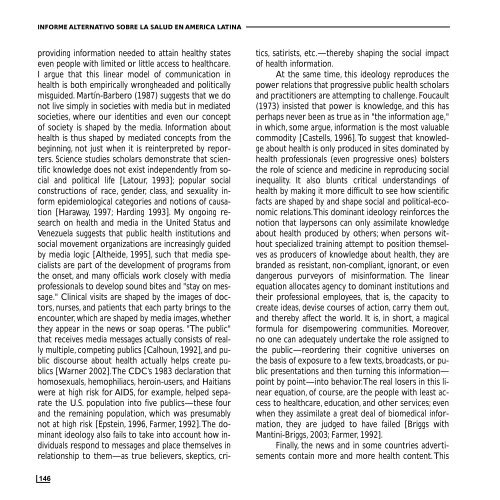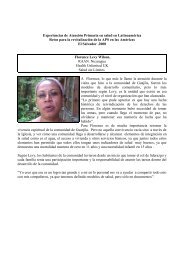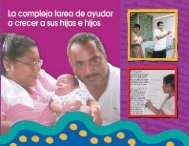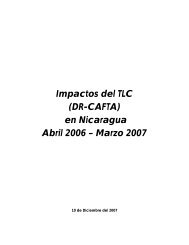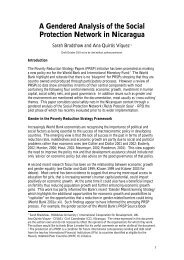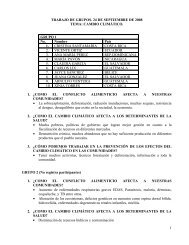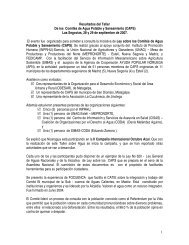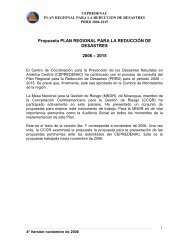Download - CISAS | Centro de Información y Servicios de AsesorÃa ...
Download - CISAS | Centro de Información y Servicios de AsesorÃa ...
Download - CISAS | Centro de Información y Servicios de AsesorÃa ...
Create successful ePaper yourself
Turn your PDF publications into a flip-book with our unique Google optimized e-Paper software.
INFORME ALTERNATIVO SOBRE LA SALUD EN AMERICA LATINAproviding information nee<strong>de</strong>d to attain healthy stateseven people with limited or little access to healthcare.I argue that this linear mo<strong>de</strong>l of communication inhealth is both empirically wronghea<strong>de</strong>d and politicallymisgui<strong>de</strong>d. Martín-Barbero (1987) suggests that we donot live simply in societies with media but in mediatedsocieties, where our i<strong>de</strong>ntities and even our conceptof society is shaped by the media. Information abouthealth is thus shaped by mediated concepts from thebeginning, not just when it is reinterpreted by reporters.Science studies scholars <strong>de</strong>monstrate that scientificknowledge does not exist in<strong>de</strong>pen<strong>de</strong>ntly from socialand political life [Latour, 1993]; popular socialconstructions of race, gen<strong>de</strong>r, class, and sexuality informepi<strong>de</strong>miological categories and notions of causation[Haraway, 1997; Harding 1993]. My ongoing researchon health and media in the United Status andVenezuela suggests that public health institutions andsocial movement organizations are increasingly gui<strong>de</strong>dby media logic [Althei<strong>de</strong>, 1995], such that media specialistsare part of the <strong>de</strong>velopment of programs fromthe onset, and many officials work closely with mediaprofessionals to <strong>de</strong>velop sound bites and "stay on message."Clinical visits are shaped by the images of doctors,nurses, and patients that each party brings to theencounter, which are shaped by media images, whetherthey appear in the news or soap operas. "The public"that receives media messages actually consists of reallymultiple, competing publics [Calhoun, 1992], and publicdiscourse about health actually helps create publics[Warner 2002].The CDC’s 1983 <strong>de</strong>claration thathomosexuals, hemophiliacs, heroin-users, and Haitianswere at high risk for AIDS, for example, helped separatethe U.S. population into five publics—these fourand the remaining population, which was presumablynot at high risk [Epstein, 1996, Farmer, 1992].The dominanti<strong>de</strong>ology also fails to take into account how individualsrespond to messages and place themselves inrelationship to them—as true believers, skeptics, critics,satirists, etc.—thereby shaping the social impactof health information.At the same time, this i<strong>de</strong>ology reproduces thepower relations that progressive public health scholarsand practitioners are attempting to challenge. Foucault(1973) insisted that power is knowledge, and this hasperhaps never been as true as in "the information age,"in which, some argue, information is the most valuablecommodity [Castells, 1996].To suggest that knowledgeabout health is only produced in sites dominated byhealth professionals (even progressive ones) bolstersthe role of science and medicine in reproducing socialinequality. It also blunts critical un<strong>de</strong>rstandings ofhealth by making it more difficult to see how scientificfacts are shaped by and shape social and political-economicrelations.This dominant i<strong>de</strong>ology reinforces thenotion that laypersons can only assimilate knowledgeabout health produced by others; when persons withoutspecialized training attempt to position themselvesas producers of knowledge about health, they arebran<strong>de</strong>d as resistant, non-compliant, ignorant, or evendangerous purveyors of misinformation. The linearequation allocates agency to dominant institutions andtheir professional employees, that is, the capacity tocreate i<strong>de</strong>as, <strong>de</strong>vise courses of action, carry them out,and thereby affect the world. It is, in short, a magicalformula for disempowering communities. Moreover,no one can a<strong>de</strong>quately un<strong>de</strong>rtake the role assigned tothe public—reor<strong>de</strong>ring their cognitive universes onthe basis of exposure to a few texts, broadcasts, or publicpresentations and then turning this information—point by point—into behavior.The real losers in this linearequation, of course, are the people with least accessto healthcare, education, and other services; evenwhen they assimilate a great <strong>de</strong>al of biomedical information,they are judged to have failed [Briggs withMantini-Briggs, 2003; Farmer, 1992].Finally, the news and in some countries advertisementscontain more and more health content. This146


